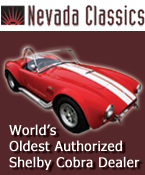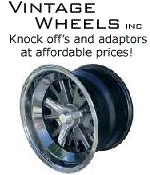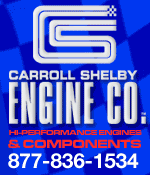 
 Main Menu
Main Menu
|
 Nevada Classics
Nevada Classics
|
 Advertise at CC
Advertise at CC
|
 January 2025
January 2025
|
| S |
M |
T |
W |
T |
F |
S |
| |
|
|
1 |
2 |
3 |
4 |
| 5 |
6 |
7 |
8 |
9 |
10 |
11 |
| 12 |
13 |
14 |
15 |
16 |
17 |
18 |
| 19 |
20 |
21 |
22 |
23 |
24 |
25 |
| 26 |
27 |
28 |
29 |
30 |
31 |
|
|
 CC Advertisers
CC Advertisers
|
|

03-28-2002, 09:18 AM
|
|
CC Member

|
|
|
Join Date: Jun 2001
Location: Loveland (Cinci), OH,
Posts: 89
|
|

 Not Ranked
Not Ranked
 Need 351 Cleveland HP suggestions
Need 351 Cleveland HP suggestions
To all Cleveland Engine Experts -
I could use some help. I am running a '72 351 CJ with open chamber 4V heads. The motor was profressionally rebuilt in 1987 and has approx. 18K miles on it. The rebuild included a .030 overbore, flat top pistons, balancing, and a 3 angle valve job. Heads were resurfaced, but I don't think they were milled, so compression should be in the 9.0 to 9.5:1 range (I think).
It has a Holley mech. sec. 700 DP with 70 primary jets and 78 secondaries. Intake is an Edelbrock Performer 351-4V dual plane. Hydrolic Cam has 290 total duration on both intake and exhaust with 220 on both at .050. Lift is .505, overlap 62 degrees. It does NOT have roller lifters nor rockers.
The previous (2nd) owner installed restrictor plates on the intake side, but the exhaust side plates are in the trunk of the car. Header tubes are either 1 7/8" or 2" diameter. Timing is set at 16 initial and 36 total.
After a recent tune-up, it was chassis dyno'd with results of 233 hp and 287 torque, but it was still running rather rich.
It seems there should be more streetable HP in this engine, even before swapping parts, I'm just not sure where, nor what mods have the best return for the dollar. Also, I keep getting conflicting suggestions - some say put the exhaust plates on, or better yet, switch to the Aussie heads. Others say pull the intake plates out and let it breathe. Still others say change the cam. Others suggest porting the heads, when yet others say they breathe too well for the street.
I would think these could rather easily be 400-450 HP motors, getting 300-350 to the rear wheels. Yet mine, with typical modifications, barely outperforms stock.
What suggestions do you have? What gains can I expect? What cost should I prepare for?
Thanks,
Keith

|
-
Advertising


03-28-2002, 10:46 AM
|
 |
Senior Club Cobra Member

|
|
|
Join Date: Dec 1999
Location: Edgewater,
FL
Cobra Make, Engine: ERA FIA, BOSS 351C/Webers
Posts: 1,304
|
|

 Not Ranked
Not Ranked
 In with the Exhaust Port Plates, OUT with the Intake ones
In with the Exhaust Port Plates, OUT with the Intake ones
Without spending much money, you could remove the Intake port plates, and install the Exhaust port plates. The guy who did my heads told me his experience was that the Exhaust plates worked, while the intake plates don't.
After I tried that, I'd be thinking about a 650cfm Holley with vacuum secondaries - don't think you need the mechanical secondaries on a street engine. ('course, then again, you ARE talking to a guy who has FOUR carburetors on top of HIS Cleveland) 
Good luck!
cobrajeff
__________________
CobraJeff
ERA P 202
|

03-28-2002, 12:23 PM
|
|
CC Member

|
|
|
Join Date: Mar 2002
Location: Belleville,
MI
Cobra Make, Engine: Still Dreaming!
Posts: 28
|
|

 Not Ranked
Not Ranked
 cleveland talk
cleveland talk
I've run a few clevelands over the years and read up a lot on these engines. Open chamber 4bl heads, strange, most of the 4bl heads I've ever seen were closed chamber yielding near 11:1 compression ratio with flat top pistons.
I've always heard and understood that the 4bl heads are too large ported / valved (2.19 I 1.72 E) for lower rpm power, but great for nascar and the like. Therefore I'd say the plates on both the intake and the exhaust would greatly improve the problem - which really boils down to port velocity.... if you make the port smaller with the same flow, the velocity will increase.
I would suspect the carburetor first and foremost. Those jets sound very large for a cam that size. Have you ever used a desk top dyno program? I'd suggest that highly to give you some idea of what you should be able to expect from this engine running optimally. Do you have access to an instrument to measure air / fuel ratio? If not, they are now available through places like summit for about $150 and are an invaluable tuning tool. I'd suggest an edlebrock carb for dependability and smooth running with no more worries of blown power valves and leaking float bowls.
What do your spark plugs look like after a good power run?
If they are sooty black you are clearly running rich as you suspect.
Optimize the carburetion, first before you go tearing things apart changing cams etc. Installing the exhaust plates should be relatively simple and only cost the price of exhaust gaskets and time.
Enjoy 

|

03-28-2002, 01:30 PM
|
|
Senior Club Cobra Member

|
|
|
Join Date: Sep 1999
Location: SHERRILLS FORD,
NC
Cobra Make, Engine: Lone Star, 351-c
Posts: 269
|
|

 Not Ranked
Not Ranked
I have yet another set of suggestions to add. I also have 72 4bbl heads. They have been milled .070" ,yielding 10.25 compression. I have a Lunati bracketmaster cam, hydraulic, not roller, 750 Holley vac secondaries, with a 65 power valve. I have both intake and exhaust port plates, way better than without, ran it both ways, but, didn't try exhaust plates only. My engine on the the dyno showed 378 hp, and 401 ft lbs of torque. I would consider the Edlebrock carb, as I have blown 2 power valves out with the "new" "blow proof" Holley carb! Yeah, right! I know you're looking for more than 400 hp, but this is what I got, and, although I want more power, I've decided the car is pretty lethal as it is. Also, my jets are what came with the 750, tried up and down, went back to what it was shipped with. Sorry, can't remember what size they are, but get 15 mpg if I don't push it.
__________________
CHRIS POTTER
|

03-28-2002, 02:18 PM
|
|
CC Member

|
|
|
Join Date: May 2001
Location: niceville fl,
fl
Cobra Make, Engine: Hunter #28; 396 Cleveland stroker; more than 495 HP; TKO 5 speed
Posts: 442
|
|

 Not Ranked
Not Ranked
Sounds like something is not quite right.
Bill Parham: http://www.southernautomotiveengines.com/
make a cobra streetable 351c at 425 hp and he says his numbers are conservative.
You might start with a compression testing and determine your compression.
You might want to talk tol him; he's built and dyno'ed many Cobra engines. |

03-28-2002, 11:11 PM
|
|
CC Member

|
|
|
Join Date: Jan 2000
Location: Senoia,
GA
Cobra Make, Engine: Everett-Morrison, Boss 351 w/ TKO 5 speed, 94 vette suspension
Posts: 76
|
|

 Not Ranked
Not Ranked

Hello Keith, I'm also using 4V open chamber heads with 9.25 compression; static. I tried the edelbrock carbs (both 600 & 750) and there o.k. for just driving but not so great for making power. I ended up having a holley 750 dp built for the car by Reed cams. That was one of the best investments I have made for my cobra. The problem with 4V heads is the there isn't a lot of vacum at lower rpm's (because of the volume) and the carb has a hard time picking up the signal. My carb has down leg bosters in it to compesate for the week signle. I have also pushed up my timing to almost 20 deg initial and somewere around 40 deg total not including what the vacum advance adds (MSD 6AL).
I'm running a custom ground solid roller cam from MPG that specs out at .588 lift @ 288 duration so I've got a lot more cam than you, but the engine runs great. I have NEVER had any kind of problems related to having to much carburator, and as long as your car is straight shift I would stick with the double pumper.
What kind of ignition are you using, and how fast does your total timing advance come in? I do think your jetting is a little rich. If you would like any more details on my carb let me know and I'll email them to you.
You will find that the Pantera guys are the ones to talk to about making a Cleveland run. They have been a BIG help in getting my car to run as well as it does.
Tim
__________________
A Hundred Years From Now It Will Not Matter What My Bank Account Was, The Sort of House I Lived In, or The Kind of Car I drove, But The World May Be Different Because I Was Important In The Life of A Child.
|

03-29-2002, 06:27 AM
|
|
CC Member

|
|
|
Join Date: Jun 2000
Location: Yardley, PA 19067,
Posts: 175
|
|

 Not Ranked
Not Ranked

Hello Keith,
I am running a slightly different engine, Windsor block and 2V Cleveland heads. My experience has been that a 750 Holley was too much carb for the engine. It ran very well at full throttle but was kind of sloppy driving around town and the plugs were always wet. I went to a 650 Holley and the car has run much better since. I agree with the idea of running the exhaust port plates as well as the intakes. The 4V runners are huge and you have to do something to get fuel/air velocity up. There are a number of guys on this forum that are using port plates and speak highly of them. My 2V heads are also open chamber with 10:1 dome pistons and the machine shop calculated the compression ratio at 9.46:1. On reading your post the first thought I was the cam was pretty small. I had a similar cam in mine, 204/216, I/E @0.05 and a lift of .456/.484. Lift is actually a bit higher since I am using 1.73:1 rockers. The car ran OK but I thought it should have been making more power. The funny thing is my Dyno2000 predicts 406 hp. I found one cylinder was not making power and I am rebuilding the engine now. The heads have been gone over pretty thoroughly including adding the big 4V valves. In addition I am putting in a much larger cam, 236/246, I/E @ 0.05 and lift of .520/.538. The computer predicts 479 hp @ 6500. The engine should be back in the car in about 2 weeks and I can't wait to see how it runs.
Jack Z.

|

03-29-2002, 09:22 AM
|
|
CC Member

|
|
|
Join Date: Mar 2001
Location: greenville,sc,usa,
Posts: 64
|
|

 Not Ranked
Not Ranked
Keith,do not consider porting those 4v heads,the flow would have such low velocity at low rpms as to be very difficult to drive around town.I think Aussie heads are the best way to go on a street cobra and are readily available. chuck
|

03-30-2002, 06:58 PM
|
|
CC Member

|
|
|
Join Date: May 2001
Location: Loveland, OH,
Posts: 11
|
|

 Not Ranked
Not Ranked
 Thanks! , but still confused
Thanks! , but still confused
Gentlemen,
Thank you for your responses and suggestions. Looks like installing the exhaust side plates is the best immediate change. Followed possibly by a stronger cam once the carb is optimized.
As far some of your questions:
milner351 -
The jets are pretty much what came in the carb from Holley. I think maybe the factory primary is a 69, not a 70, but the sec is stock at 78.
I don't have access to an air/fuel meter. I'll look into that, but I need to find somplace to make the modifications to the exhaust to install them. I am not proficiant with a welder.
The plugs come out a dark grey - not exactly sooty black, but not as 'clean' as one would like.
tim -
Ignition appears to be stock '72 Ford with a Mallory Unilight distributor. I don't know for sure since I didn't build the car and the module has no readily apparent markings. Nothing under the hood looks like MSD.
As far speed of advance coming in, I don't know.
More info on your carb would be much appreciated.
I've posted on PI, but no resonses of any real help. Are there specific people or different forums that you found most helpful?
Chris -
Right now, 378 HP sounds like a long way off. Shoot, right now, I'd be excited if I could get the darn thing to 350!
Niles -
Ignorant question here - what's the process for testing compression?
I did purchase Desktop Dyno2000. I will say I am a bit perplexed though. According to it, my numbers should be much higher than they are. With inputs based on the current configuration, the program gives 364 hp and 385 ft lbs. Adjusting those for est. 18% drivetrain loss, I get 298 hp and 317. The chassis dyno showed 233 and 287. Torque is 'reasonably' close at a 9% difference, but the HP number is significantly off at a 21% diff.
Using lower performance component inputs (low perf vs wedge heads; mufflers vs open exhaust), I got closer to my actual dyno numbers with 332 HP and 353, which would be 272 and 289. Torque is almost exact, but HP is still way off. But I don't think those inputs don't reflect the motor, but maybe they do. Hence my peplextion. Does this point to something being wrong in the motor, regardless of the components?
Niles, any specific thoughts?
Also, in all the variations I used, the software spit out HP and torque numbers that were usually within 6% of each other. In any dyno run I've ever done on my car, the two figures are always over 20% apart with HP being the lower.
What affects HP significantly, but has a much lesser impact on torque. Or maybe I should state that the other way around?
Thanks again for all your help guys. I love my car and it's fun to drive, I just know it can be much funner!
Keith
__________________
~~~Tammy Hummel
|

03-30-2002, 09:16 PM
|
|
CC Member

|
|
|
Join Date: Jun 2001
Location: Loveland (Cinci), OH,
Posts: 89
|
|

 Not Ranked
Not Ranked
 Argh.
Argh.
Apparently my wife did not logout the last time she was online. Didn't notice it until after I posted the response.
Sorry for any confusion.
Keith
|

03-30-2002, 11:16 PM
|
|
CC Member

|
|
|
Join Date: May 2001
Location: niceville fl,
fl
Cobra Make, Engine: Hunter #28; 396 Cleveland stroker; more than 495 HP; TKO 5 speed
Posts: 442
|
|

 Not Ranked
Not Ranked
 351C
351C
Keith:
checking compression; is like your blood presuure; it's the most important test you can make.
It's a guage that screws into your plug holes and you turn the motor over with the starter and measure the psi of each cylinder. You could be dragging around a dead cylinder; that would explain your low dyno reading.
Should be within 10 psi of each other; your engine should be around175 psi; (any good values from people with similar engines?
If you need more info/detail - email me
gn
|

03-31-2002, 01:13 PM
|
 |
Senior Club Cobra Member

|
|
|
Join Date: May 2001
Cobra Make, Engine: A CSX Cobra,1966 GT350 and an '06 Ford Heritage GT
Posts: 1,829
|
|

 Not Ranked
Not Ranked

Another alternative...
WHAT GEAR ARE YOU RUNNING IN THE DIFFERENTIAL?? WHAT TRANS?? If your car is running around with 3.08 gears behind a C it will always feel like a slug because Clevelands like to rev, and it would also explain why the plugs are not self-cleaning. Bang for the buck, a gear change will give you the most seat of the pants change. Also, tire choice affects feel as well...a tall tire raises final gear ratio. For example, if you have 4.11 gears with a 225/60/15 tire and change to a 275/60/15, the net result would feel like you are running 3.73's on the old tires! If you post some drivetrain info I can explain further...if you dont know what gear is in the car, tell me what you are turning (rpm) at 60 and what tire you have (size). Also, what kind of trans (4 or 5 speed?). If you do this I think you can liven up your car considerably for very little $, and still have a driver! All the horsepower and torque in the world is useless unless you set the chassis up to use it! 
__________________
"I think we have more machinery of government than is necessary, too many parasites living on the labor of the industrious." Thomas Jefferson
|

03-31-2002, 02:54 PM
|
|
CC Member

|
|
|
Join Date: Jun 2001
Location: Loveland (Cinci), OH,
Posts: 89
|
|

 Not Ranked
Not Ranked
niles -
Thanks for the comp check info. I knew about the spark plug hole guage, I just never had any idea how to interpret what it was saying relative to CR. Looks like a Monday morning trip to the tool store...
427sharpe -
I've got 3.54's in the diff, with 295/50R15 tires.
Thanks again for all your continued input guys. It is very much appreciated!
Keith
|

03-31-2002, 02:55 PM
|
|
CC Member

|
|
|
Join Date: Jun 2001
Location: Loveland (Cinci), OH,
Posts: 89
|
|

 Not Ranked
Not Ranked
 Forget the tranny info
Forget the tranny info
427sharpe -
Sorry about that. Tranny is a 4spd top loader.
Thanks,
Keith
|

03-31-2002, 06:53 PM
|
 |
CC Member

|
|
|
Join Date: Aug 2000
Location: Chicago,
IL
Cobra Make, Engine: ERA 454 S.O.
Posts: 1,684
|
|

 Not Ranked
Not Ranked
When you check the compression, do it with the engine hot, all the plugs out at the same time, and the carb. held wide open. Use something to hold the carb. open so you don't wash the cylinders down with the gas from the accelerator pump every time you open the carb.
__________________
Jeff
“If you can make black marks on a straight from the time you turn out of a corner until the braking point of the next turn, then you have enough horsepower.”
Mark Donahue
|

03-31-2002, 09:54 PM
|
|
CC Member

|
|
|
Join Date: Apr 2000
Location: Channel Islands Harbor (Oxnard, CA),
ca
Cobra Make, Engine: Classic Roadster, 351Cleveland
Posts: 172
|
|

 Not Ranked
Not Ranked
Check out the following sites. They are strictly 351 Cleveland sites with lots of good information.  http://www.network54.com/Hide/Forum/119419
http://www.network54.com/Hide/Forum/119419
and
http://www.waldens.com/waldens/fmotorsp.htm
Hope they will be of some help.
John Wais
Last edited by John Wais; 03-31-2002 at 10:10 PM..
|

04-02-2002, 06:42 PM
|
|
CC Member

|
|
|
Join Date: Apr 2000
Location: Gainesville, Fl USA,
Posts: 298
|
|

 Not Ranked
Not Ranked

Keith,
You’ve received a lot of good responses here. I’ll add mine to the pot as well. Like you, I have a 351C with 2” primaries. And this is a big problem. I am preparing to build a new set of headers (I dropped the engine and moved it back, so an off the shelf set from my manufacturer won’t fit) that are 1-3/4” to improve port velocity. 1-3/4” diameter primaries should be fine for 450 hp, which is my goal in the end. I realize this is not a cheap or easy solution, though it’s probably one reason you’re motor seems sluggish down low.
As far as the 4V heads—especially the open chamber ones—you don’t really have a big enough cam, displacement or compression to use them. The ports and valves, as others have said, are simply too big. They work well with strokers, 10+:1 compression and high rpms. On a relatively mild engine like yours, the large ports give low vacuum signals at low rpms, so it’s difficult to get low end driveability. Jeff gets away with it because he’s running an awesome indepented runner induction system, and Tim was able to improve his low speed tractability by having his carb tuned to so it’s booster venturis are more sensitive. This is a good place to start, as it sounds like Tim has had good results with a similar setup
The port plates will help, but they aren’t the answer, but rather (in my opinion) a band-aid. If it were me, and I always try to do things on a budget, as I’m sure you are trying to as well, I would suggest the following. Swap or sell your 4V heads for a nice pair of 2V heads. Do the same with your intake. Since someone buying the 4V parts would be “upgrading”, you will probably come out slightly ahead money wise, so it’s not an expensive proposition. If you want to spice things up a hair, get a pair ot 2V heads that have a little cleanup on the intake ports, but leave the exhausts alone. Or better yet, buy a pair of 2V Aussie heads which have ports slightly larger than the US 2V heads, but have a quench combustion chamber that raises the compression 1 point without any problems with detonation. Edelbrock, Weiand and Holley all make nice 2V dual plane intakes that will work well with these heads and you can pick them up for between $100 and $150 used.
Here's an interesting discussion of the port plate you might find insightful:
http://www.network54.com/Hide/Forum/...eid=1014127496
Finally, I would go with more cam, something similar to what Tim is running or maybe something along the lines of the Crane H-290 (formerly Fireball II 290) cam:
http://www.cranecams.com/master/apps/ford37.htm
I think there is still a lot of tuning left in your current combo, and that’s where I would start. I just stated the above as food for thought. If you want an engine with low end torque and moderate HP at the top end, 4V heads probably aren’t the best choice. If you are willing to sacrifice a little torque down low in exchange for some more HP up top, you can do it with the 4V heads, but you really need more compression and cam to make best use of them. But as others have shown, you can more than likely reach your target of 350 with a cam swap and some tuning. I think you’ll be giving up a noticeable amount of torque with the huge headers though. So my opinion would be to try installing the exhaust port plates, verify your cam timing with a timing wheel to make sure the cam was installed properly (or swap in a bigger cam if you wish), borrow a 600 or 650 cfm vacuum secondary carb and play with your timing. You need a way to quantify the results though, so a G-tech or other type of performance measuring accelerometer might be a prudent investment for the $140 they run. Please keep us posted and let’s see what we can do!
Last edited by Mike Braddock; 04-03-2002 at 09:30 AM..
|

04-03-2002, 04:20 PM
|
|
CC Member

|
|
|
Join Date: Jun 2001
Location: Loveland (Cinci), OH,
Posts: 89
|
|

 Not Ranked
Not Ranked
 Will do!
Will do!
Thanks Mike!
I have a GTech already, and just scoped out a place to make use of it.
The oil pan is currently off the car and I am awaiting delivery of a windage tray that should arrive by this weekend. Once the car's back together I'll do some base line runs with the GTech and then follw that up with the compression test.
Presuming I don't have a bad cylinder, next step would be to install the exhaust side plates and do more runs with the GTech.
I'll post my results.
I did have a question on the cam you recommended. Maybe I am reading the specs wrong (or maybe reading the wrong specs), but it looks like the H-290 actually has less duration at .050 than what I am currently running, 216 vs 220, although it does have more lift, .524 vs .505. So, is it really that much more aggressive of a cam? In addition to the lift increase, I was thinking I would need duration figures in the low 230's. While I'm asking about cams, do roller cams really generate 30-40 additional HP over non-roller cams?
Thank you for your continued suggetions,
Keith

|

04-05-2002, 11:08 PM
|
|
CC Member

|
|
|
Join Date: Jan 2000
Location: Senoia,
GA
Cobra Make, Engine: Everett-Morrison, Boss 351 w/ TKO 5 speed, 94 vette suspension
Posts: 76
|
|

 Not Ranked
Not Ranked

Keith, I would like to give you some more input. The aussie 2V heads that Mike mentioned will help low end torque with increased port velocity but there not going to improve HP numbers. Also, if you consider the swap to closed chamber heads be aware that depending on your pistons and the chamber volume of both heads you could increase your compression as much as 2 points. The following web address is for Keith Black piston info. http://www.kb-silvolite.com/page45.htm#SECT2 You don't need torque in a 2500lb straight shift car you need horse power.
You asked about the exhaust port plates and would they help? I think they will because the exhuast port on a cleveland 2V or 4V is a bad design. The exhaust exits the chamber going up into the port and then has to turn down to exit the head. The plate will actually even the port out and make it a more uniformed size. The aftermarket world has figured this out and raised the exhaust ports dramaticly to improve exhaust flow. Just for you information the exhaust ports on 2V & 4V heads are almost the same size at there smallest point were they turn 90 degrees in the head. The 4V head exhaust port is a little wider but is the sams hieght. (see atached photo).
As for carburetors, any custom carb shop will tell you vacuum secondaries are for automatics and mechanical secondaries are for straight shift transmissions. Edelbrock carbs are good for daily drivers but they are not for high HP applications. They don't respond well to the low vaccum signals that big cams tend to produce. I would stay with your Holley for now and just try to tune it a little more. By the way my carb specs are as follows:
Flow(cfm) 880
Main jets: pri. 73 sec. 83
Power valve: pri. 6.5
Nozzle size: pri. .028 sec. .031
You also said that you were a bit perplexed with your Desktop Dyno. I'll tell you what I have found to work with mine. Input head flow information instead of using there generic selections. If you do a search on the web you will find sites that have head flow information for a cleveland. It may not be exactly what you have but it will make a diference in the end results. You can also get all the information you need from Cranes web site to input diferent cams. http://www.cranecams.com/CraneCams.htm I have built a library of head and cam information in my Desktop dyno and it helps when I want to experament with different ideas. You will probably find that your cam is on the smaller side and that changing it will yeild the biggest results but use your Desktop Dyno to compare different cams. It really does work.
I figure you will need to perform a compression check just to make sure all 8 cylinders are good. Then I would start working with the carburetor and the distributor. A vacuum gauge is also a very useful tool when fine tuning. I would like to know what kind of advance curve your distributor has been set to, and do you have a vacuum advance or is it just mechanical?
Bottom line is don't be afraid of those 4V heads. They will make horse power and lots of it even on the street. You just need to optimize everything around them to get the best performance. Thats what your Desktop Dyno is for.
Tim  
Last edited by tim; 04-05-2002 at 11:45 PM..
|

04-05-2002, 11:18 PM
|
|
CC Member

|
|
|
Join Date: Jan 2000
Location: Senoia,
GA
Cobra Make, Engine: Everett-Morrison, Boss 351 w/ TKO 5 speed, 94 vette suspension
Posts: 76
|
|

 Not Ranked
Not Ranked
tim
Last edited by tim; 04-05-2002 at 11:27 PM..
|
 Posting Rules
Posting Rules
|
You may not post new threads
You may not post replies
You may not post attachments
You may not edit your posts
HTML code is On
|
|
|
All times are GMT -7. The time now is 07:56 AM.
|






















 Linear Mode
Linear Mode



